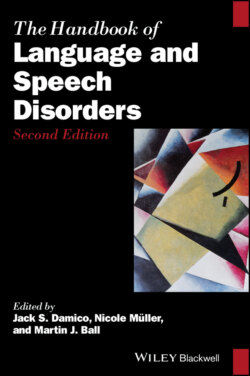Читать книгу The Handbook of Language and Speech Disorders - Группа авторов - Страница 42
3.2.2 Physiological Correlates of Noise‐Induced Hearing Loss
ОглавлениеOur understanding of the physiological changes that contribute to noise‐induced hearing loss have recently undergone substantial revision. Previously, exposure to high‐intensity sounds were thought to lead to the mechanical damage of structures in the cochlea, including the sensory stereocilia of the inner hair cells and also to secondary effects that included the mixing of fluid from the normally separate cochlear compartments and alteration of the supporting cells (Slepecky, 1986). Noise‐induced damages to the cochlea have now been attributed not only to direct mechanical stress, but also to secondary metabolic disruption. Direct mechanical stress occurs during noise exposure when acoustic stimuli apply a physical force to the cochlea causing immediate trauma. Metabolic disruption is likewise initiated during noise exposure, but the effects continue to develop for a number of weeks after the cessation of noise exposure.
The damage to the cochlea can be either reversible, when there is only a slight structural insult resulting in a temporary threshold shift, or irreversible if the damage is severe, causing permanent hearing loss. The most important alteration in cochlear morphology after intense noise exposure is the degeneration of hair cells in the organ of Corti. The degeneration usually occurs in clusters and causes hair cell lesions, the site of which is directly related to the intensity and spectral content of the noise. In this tonotopic fashion, high‐frequency noise damages the basal end of the organ of Corti, while low‐frequency noise damages the apical portion. High‐intensity noises have a wider spread of damage, while low‐intensity noises cause more focal lesions. The severity of hair cell impairment is a function of the nature and the conditions of the noise. More severe damage is associated with higher intensity levels, high‐frequency noise, and continuous exposure to noise (Hu, 2012).
One of the most consequential revisions to our understanding of the causes of noise‐induced hearing loss is that the connection between afferent nerve terminals and sensory hair cells is likely to be compromised at a stage that pre‐dates morphological damage to the hair cell (Kujawa & Liberman, 2009). This disconnection between sensory cell and neural relay system selectively affects auditory nerve fibers that transmit supra‐threshold stimuli, that is, those with a low spontaneous firing rate and a high activation threshold. The perceptual consequence of this disconnection is that challenging tasks, like listening in noise, become harder, while auditory thresholds remain unchanged. This, in turn, has prompted a fundamental re‐evaluation of the previously widely held view that only noise exposure resulting in permanent threshold shifts is damaging to hearing (Liberman, 2017).
